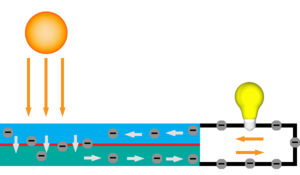Translations:PV module/1/en
Jump to navigation
Jump to search
Solar photovoltaic (PV) modules use the photovoltaic (PV) effect to generate electrical current upon exposure to light. When sufficient light hits a PV cell, current is generated which excites electrons that then pass through a one-way barrier or junction forcing them to flow through a circuit to return to their point of origin. These movement of these electrons can be used to do work or power loads. There are many different technologies available and ways to design a system that can meet needs that range from simple lighting, to running appliances, pumping water or powering cities.

